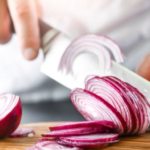Introduction:
Lobster tails are a luxurious and delectable seafood option that can add a touch of elegance to any dining occasion. Whether you’re planning a romantic dinner, a festive celebration, or just looking to indulge in a gourmet experience, knowing how to properly cut and prepare lobster tail is essential. In this comprehensive guide, we will walk you through the steps of cutting lobster tail, offering tips and tricks to ensure a perfect outcome every time.
Choosing the Right Lobster Tail:

Size and Variety: Lobster tails come in various sizes and from different parts of the world. The most common varieties include Maine lobster, rock lobster, and spiny lobster. The size of the tail you choose will depend on your personal preference and the number of people you are serving.
Freshness: Always opt for fresh or properly frozen lobster tails. Fresh tails should have a clean, ocean-like smell, while frozen tails should be well-packed with no signs of freezer burn.
Preparing the Lobster Tail:

Thawing: If your lobster tails are frozen, you need to thaw them completely before cutting. Place them in the refrigerator for 24 hours or use the defrost function on your microwave if you’re short on time.
Cleaning: Rinse the lobster tails under cold running water to remove any debris or impurities. Pat them dry with paper towels.
The Cutting Process:

Shell Side Up: Place the lobster tail on a cutting board with the shell side facing up. Ensure that the tail is laying flat and stable.
Cutting the Shell: Using a sharp pair of kitchen shears, cut through the top of the shell starting from the end closest to the body and stopping just before the tail fin. Be careful not to cut through the meat; you only want to cut the shell.
Loosening the Meat: Gently spread the shell open where you made the cut. Use your fingers to carefully separate the meat from the shell, lifting it slightly while still keeping it attached at the base near the tail fin.
Butterflying: For a butterfly presentation, you can cut through the meat (not the bottom shell) along the same line you cut the shell, spreading the meat open to lay flat on top of the shell.
Removing the Vein: If there is a visible black vein running down the back of the meat, use the tip of your knife to lift it out and discard it. This is the lobster’s digestive tract, and while it’s not harmful, it can have a gritty texture.
Cooking the Lobster Tail:

Seasoning: Brush the lobster meat with melted butter, olive oil, or your marinade of choice. Season with salt, pepper, and any other seasonings you prefer.
Grilling: Preheat your grill to medium-high heat. Place the lobster tails shell side down on the grill and cook for 5-7 minutes, until the shell turns bright red. Flip the tails over and grill for an additional 4-5 minutes, or until the meat is opaque and cooked through.
Broiling: Preheat your broiler. Place the lobster tails on a baking sheet, cut side up. Broil for 5-10 minutes, or until the meat is opaque and cooked through. Be sure to keep a close eye on them to prevent burning.
Baking: Preheat your oven to 350°F (175°C). Place the lobster tails on a baking sheet, cut side up. Bake for 15-20 minutes, or until the meat is opaque and cooked through.
Steaming: Fill a pot with 1 inch of water and bring to a boil. Place a steaming basket in the pot and add the lobster tails. Cover and steam for 8-10 minutes, or until the meat is opaque and cooked through.
Conclusion:
Mastering the art of cutting lobster tail is a skill that can elevate your culinary prowess and impress your guests. With practice, patience, and the right tools, you can create a stunning and delicious seafood feast that showcases the luxurious and savory flavors of lobster. Remember to choose high-quality, fresh lobster tails, handle them with care, and cook them to perfection. Enjoy your gourmet adventure with this exquisite ingredient!
FAQs (How to Cut Lobster Tail)
Cutting lobster tails allows for even cooking, makes it easier to eat, and presents beautifully on the plate. It can also allow for better marination and seasoning penetration.
While the vein is edible, it’s recommended to remove it because it contains the lobster’s digestive tract which can be gritty and unappetizing to some
A sharp pair of kitchen shears is the primary tool needed. For additional preparations, a sharp knife might also be helpful.
It’s best to thoroughly thaw the lobster tail before cutting. This makes the process easier and reduces the risk of injury.
Butterflying refers to the method of cutting the lobster tail so that the meat can be spread out and laid on top of the shell, resembling butterfly wings.
When cutting the shell, ensure you only cut the shell and not deep into the meat. If you’re butterflying, you’ll cut the meat slightly but ensure it remains attached at the base.
Yes, depending on your recipe, you can cut the lobster tail meat into chunks. Just ensure you remove it from the shell first.
The method is generally the same for most lobster tails, whether they’re Maine, rock, or spiny lobsters. The primary difference will be in size and meat texture.
By cutting and butterflying the tail, it naturally reduces curling. Some chefs also insert a skewer lengthwise through the lobster tail to keep it straight during cooking.
A fresh lobster tail will have a firm texture and a pleasant, ocean-like smell. If it emits a strong, ammonia-like odor, it’s a sign that it’s not fresh.
The cooking method depends on personal preference. Grilling offers a smoky flavor, baking and broiling give a nice roasted finish, while steaming preserves the lobster’s natural taste. No matter the method, ensure the meat turns opaque and is cooked through.



GIPHY App Key not set. Please check settings
One Comment